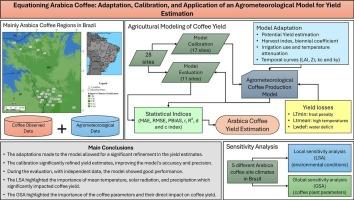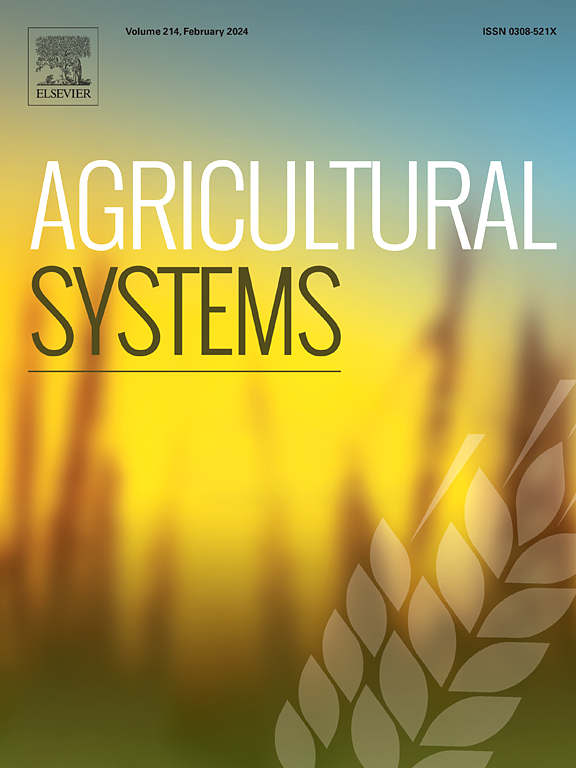Equationing Arabica coffee: Adaptation, calibration, and application of an agrometeorological model for yield estimation
IF 6.1
1区 农林科学
Q1 AGRICULTURE, MULTIDISCIPLINARY
引用次数: 0
Abstract
CONTEXT
Coffee cultivation is important to Brazil's economy, positioning the country as a global leader in production and export. Given the complex environmental and management factors affecting yields, particularly due to climate change, there is a pressing need from farmers and dealers for more precise crop estimation models.
OBJECTIVE
This study aimed to refine and calibrate an agrometeorological model, originally developed by Santos and Camargo (2006) and later adapted by Verhage et al. (2017a), to estimate Arabica coffee yield in the main producing regions of Minas Gerais and São Paulo. Additionally, sensitivity analysis was also performed to identify the most influential model parameters and variables.
METHODS
Yield data from 28 coffee-producing locations (2003−2020) and meteorological data alongside irrigation use were employed. Following calibration and adaptation, a sensitivity analysis was conducted to determine the model's response to variations in coffee plant parameters and environmental conditions. Local sensitivity analysis (LSA) focused on meteorological variables, while global sensitivity analysis (GSA) addressed coffee-related parameters.
RESULTS AND CONCLUSIONS
The adaptations proposed to the original model led to a significant refinement in the yield estimates, emphasizing the complex interactions between climatic variables and agricultural management practices. Key adaptations include the estimation of potential yield (Yp), the incorporation of temporal curves for root growth, leaf area index, available water capacity, and crop coefficient, as well as a water balance that accounts for irrigation and its effect on attenuating high canopy temperatures. Calibration improved the model's accuracy and precision, with the RMSE decreasing from 13.66 (819.6 kg ha−1; 1 bag ha−1 = 60 kg ha−1) to 8.65 (519.0 kg ha−1) bags ha−1, R2 improving from 0.62 to 0.65, d-index from 0.79 to 0.88, and NSE from 0.09 to 0.64. During the evaluation phase, with independent data, RMSE was 7.76 bags ha−1 (465.6 kg ha−1), d-index 0.85, and R2 0.55. Sensitivity analysis emphasized the importance of mean temperature and solar radiation on Yp, as well as the impact of irrigation practices and water deficit management under rainfed conditions. Additionally, factors specific to the coffee plant itself directly affect its yield.
SIGNIFICANCE
The findings underscore the importance of a multifactorial and adaptive approach to coffee cultivation, addressing the complexities and challenges posed by varying climatic conditions. This work offers valuable insights into optimizing coffee production, presenting the model as a tool for developing more resilient cultivation strategies and enhancing the sustainability of Brazilian Arabica coffee in future climate change scenarios.

阿拉比卡咖啡的方程式:产量估算的农业气象模型的适应、校准和应用
咖啡种植对巴西经济至关重要,使该国成为咖啡生产和出口的全球领导者。考虑到影响产量的复杂环境和管理因素,特别是由于气候变化,农民和经销商迫切需要更精确的作物估计模型。本研究旨在完善和校准一个农业气象模型,该模型最初由Santos和Camargo(2006)开发,后来由Verhage等人(2017a)进行调整,以估计米纳斯吉拉斯州和圣保罗州主要产区的阿拉比卡咖啡产量。此外,还进行了敏感性分析,以确定最具影响力的模型参数和变量。方法采用来自28个咖啡产地(2003 - 2020年)的产量数据和灌溉使用的气象数据。在校准和适应之后,进行了敏感性分析,以确定模型对咖啡植物参数和环境条件变化的响应。局部敏感性分析(LSA)侧重于气象变量,而全局敏感性分析(GSA)侧重于与咖啡相关的参数。结果与结论对原始模型的调整使得产量估算有了显著的改进,强调了气候变量和农业管理实践之间复杂的相互作用。关键的适应包括潜在产量(Yp)的估计,根系生长的时间曲线、叶面积指数、有效水分容量和作物系数的结合,以及解释灌溉及其对降低冠层高温的影响的水分平衡。校正提高了模型的准确度和精度,RMSE从13.66 (819.6 kg ha−1;1袋ha−1 = 60 kg ha−1)至8.65 (519.0 kg ha−1)袋ha−1,R2从0.62提高到0.65,d指数从0.79提高到0.88,NSE从0.09提高到0.64。在评估阶段,使用独立数据,RMSE为7.76袋ha - 1 (465.6 kg ha - 1), d指数为0.85,R2为0.55。敏感性分析强调了平均温度和太阳辐射对Yp的重要性,以及灌溉方式和旱作条件下水分亏缺管理的影响。此外,咖啡树自身特有的因素直接影响其产量。研究结果强调了多因素和适应性方法对咖啡种植的重要性,解决了气候条件变化带来的复杂性和挑战。这项工作为优化咖啡生产提供了有价值的见解,将该模型作为制定更具弹性的种植策略和提高巴西阿拉比卡咖啡在未来气候变化情景下的可持续性的工具。
本文章由计算机程序翻译,如有差异,请以英文原文为准。
求助全文
约1分钟内获得全文
求助全文
来源期刊

Agricultural Systems
农林科学-农业综合
CiteScore
13.30
自引率
7.60%
发文量
174
审稿时长
30 days
期刊介绍:
Agricultural Systems is an international journal that deals with interactions - among the components of agricultural systems, among hierarchical levels of agricultural systems, between agricultural and other land use systems, and between agricultural systems and their natural, social and economic environments.
The scope includes the development and application of systems analysis methodologies in the following areas:
Systems approaches in the sustainable intensification of agriculture; pathways for sustainable intensification; crop-livestock integration; farm-level resource allocation; quantification of benefits and trade-offs at farm to landscape levels; integrative, participatory and dynamic modelling approaches for qualitative and quantitative assessments of agricultural systems and decision making;
The interactions between agricultural and non-agricultural landscapes; the multiple services of agricultural systems; food security and the environment;
Global change and adaptation science; transformational adaptations as driven by changes in climate, policy, values and attitudes influencing the design of farming systems;
Development and application of farming systems design tools and methods for impact, scenario and case study analysis; managing the complexities of dynamic agricultural systems; innovation systems and multi stakeholder arrangements that support or promote change and (or) inform policy decisions.
 求助内容:
求助内容: 应助结果提醒方式:
应助结果提醒方式:


